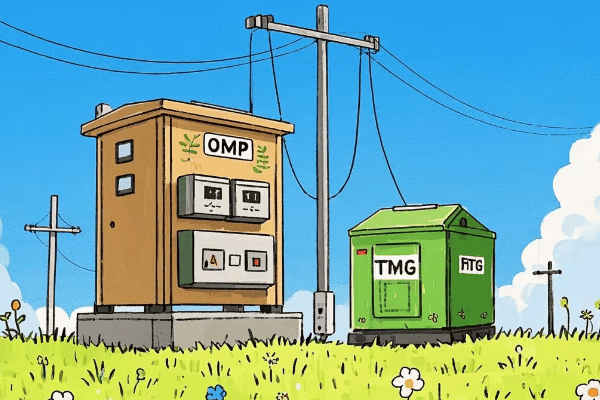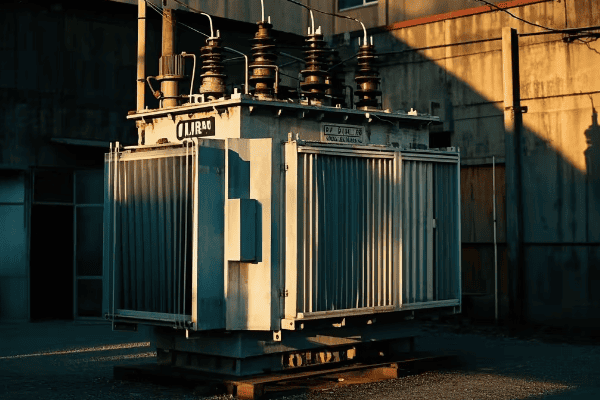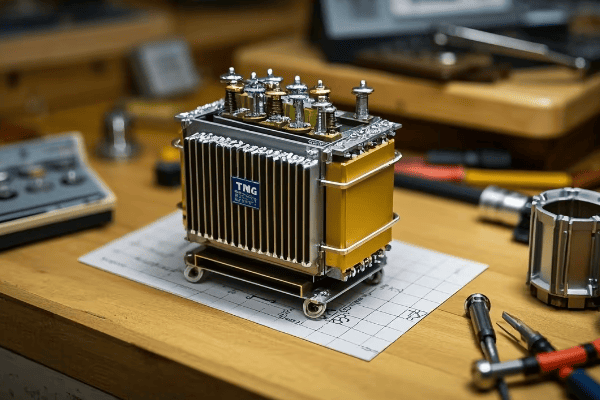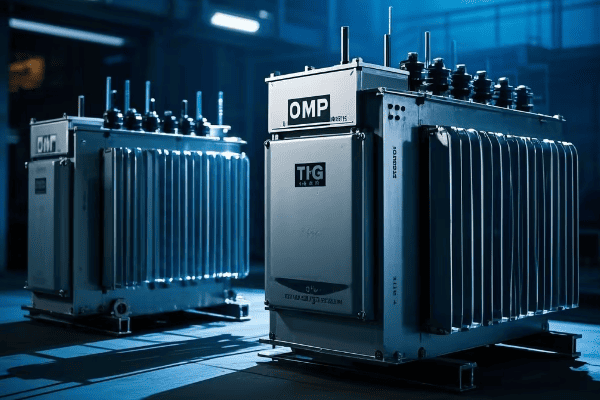OMP vs TMG Transformers: Understanding Key Differences in Power Distribution
Have you ever wondered why some electrical transformers are shaped like cylinders while others look like boxes with fins? The answer lies in the specific design of OMP and TMG transformers, two crucial components in our power distribution systems.
OMP transformers are single-phase, oil-immersed units designed for voltage step-down in various applications, including electrical supply networks and railroad systems. TMG transformers, on the other hand, are three-phase, oil-immersed units in hermetic corrugated cases, primarily used for transforming electrical energy in supply networks and consumer mains. Both types play vital roles in power distribution but have distinct characteristics suited for different applications.

As an electrical engineer with over 15 years of experience in power systems, I’ve worked extensively with both OMP and TMG transformers. Let’s dive into the world of these essential devices and uncover what makes each type unique and indispensable in modern power distribution.
What Are OMP Transformers and Where Are They Used?
Have you ever seen a small cylindrical transformer mounted on a utility pole? Chances are, you’ve spotted an OMP transformer in action.
OMP transformers are single-phase, oil-immersed converter transformers designed for stepping down voltage in electrical supply networks. They’re commonly used in power circuits of alarm equipment and railroad automatic block systems. These transformers are built to withstand extreme temperatures, operating efficiently in both temperate (-45°C to +40°C) and cold (-60°C to +40°C) climates.

Key features of OMP transformers include:
- Single-phase design
- Oil-immersed for better insulation and cooling
- Compact cylindrical shape
- Wide temperature operating range
- Primarily used for voltage step-down
I recall a project where we installed OMP transformers along a new railroad line in a mountainous region. The transformers’ ability to operate in extreme cold was crucial for maintaining reliable signaling systems throughout the harsh winter months.
Key Takeaway: OMP transformers are versatile, robust units ideal for outdoor installations in challenging environments, particularly where single-phase power is needed.
What Makes TMG Transformers Unique?
Ever noticed those large, finned boxes in electrical substations? Those are likely TMG transformers, the workhorses of power distribution.
TMG transformers are three-phase, oil-immersed units housed in hermetic corrugated cases. They’re designed for transforming electrical energy in supply networks and consumer mains. A key advantage of TMG transformers is their low maintenance requirements – they need no preventive repair or inspection throughout their operational lifetime, making them cost-effective for long-term use.

Distinctive features of TMG transformers include:
- Three-phase design
- Hermetically sealed corrugated case
- Low maintenance requirements
- Suitable for both indoor and outdoor installations
- Used in larger power distribution applications
In a recent urban development project, we chose TMG transformers for the main power distribution substations. Their low maintenance needs and reliable performance were perfect for the high-demand, continuous operation required in a growing city center.
Key Takeaway: TMG transformers offer a low-maintenance, reliable solution for three-phase power transformation, ideal for both utility and industrial applications.
How Do OMP and TMG Transformers Compare?
Choosing between OMP and TMG transformers can significantly impact your power distribution system’s efficiency and reliability. But how do they stack up against each other?
OMP and TMG transformers differ in phase count, application scope, and maintenance needs. While OMP transformers excel in single-phase, outdoor applications with extreme temperature variations, TMG transformers are preferred for three-phase systems where low maintenance and hermetic sealing are priorities.
Here’s a comparison table to highlight the key differences:
| Feature | OMP Transformer | TMG Transformer |
|---|---|---|
| Phase | Single-phase | Three-phase |
| Design | Cylindrical, oil-immersed | Rectangular, hermetically sealed |
| Temperature Range | -60°C to +40°C | Standard range (typically -20°C to +40°C) |
| Main Applications | Railroad systems, alarm circuits | Supply networks, consumer mains |
| Maintenance | Regular inspection needed | Minimal maintenance required |
| Size | Generally smaller | Larger, suited for higher capacities |
| Installation | Often pole-mounted | Usually ground-mounted |
I once consulted on a project where we needed to decide between OMP and TMG transformers for a mixed-use development. We ultimately chose OMP transformers for the residential areas due to space constraints and single-phase requirements, while opting for TMG transformers in the commercial sector to handle the higher three-phase power demands.
Key Takeaway: The choice between OMP and TMG transformers depends on specific application needs, considering factors like phase requirements, installation environment, and maintenance capabilities.
What Are the Future Trends in Transformer Technology?
As our power needs evolve, so do our transformers. But what does the future hold for OMP and TMG transformers?
Future trends in transformer technology are focusing on increased efficiency, smart monitoring capabilities, and environmental sustainability. For both OMP and TMG transformers, we’re seeing developments in biodegradable insulating oils, advanced cooling systems, and integration with smart grid technologies.

Emerging trends include:
- Use of natural ester fluids as an eco-friendly alternative to mineral oil
- Integration of IoT sensors for real-time monitoring and predictive maintenance
- Development of more compact designs for urban installations
- Improved energy efficiency to reduce losses
- Enhanced resilience against cyber threats in smart grid applications
In a recent pilot project, we tested new OMP transformers with biodegradable insulating fluid and built-in smart monitoring systems. The results were promising, showing improved environmental performance and the potential for significant long-term cost savings through predictive maintenance.
Key Takeaway: The future of both OMP and TMG transformers lies in smarter, more efficient, and environmentally friendly designs that can meet the evolving demands of our power distribution systems.
Conclusion
Understanding the differences between OMP and TMG transformers is crucial for anyone involved in power distribution system design or management. While OMP transformers offer flexibility and resilience in single-phase, often challenging environments, TMG transformers provide reliable, low-maintenance solutions for three-phase power distribution. As technology advances, both types are evolving to meet the demands of smarter, more efficient power grids. Whether you’re working on a small-scale project or a large power distribution network, choosing the right transformer type can significantly impact the system’s performance, reliability, and long-term cost-effectiveness.
FAQs: Common Questions About OMP and TMG Transformers
- Are OMP transformers more efficient than TMG transformers?
Efficiency depends on the specific application. OMP transformers are generally more efficient for smaller, single-phase applications, especially in variable temperature conditions. TMG transformers, however, can be more efficient in larger, three-phase systems due to their design and lower maintenance needs. In my experience, the efficiency difference is usually minimal when each type is used in its intended application.
- Can TMG transformers be used in extremely cold climates like OMP transformers?
While TMG transformers are robust, they’re typically not designed for the extreme temperature ranges that OMP transformers can handle. For very cold climates (below -40°C), OMP transformers are usually the better choice. However, special versions of TMG transformers can be manufactured for colder climates if necessary.
- How long do OMP and TMG transformers typically last?
Both OMP and TMG transformers are built for longevity. With proper maintenance, OMP transformers can last 20-30 years, while TMG transformers, due to their hermetic design and lower maintenance needs, often last 30-40 years or more. I’ve seen TMG transformers in operation for over 50 years, still performing efficiently.
- Are there any special installation requirements for OMP and TMG transformers?
Yes, there are. OMP transformers, being often pole-mounted, require proper support structures and consideration for weight distribution. TMG transformers, typically larger and ground-mounted, need a stable foundation and adequate clearance for cooling. Both types require proper electrical protection and grounding. Always consult local electrical codes and manufacturer guidelines for specific installation requirements.
- Can OMP and TMG transformers be used with renewable energy sources?
Yes, both can be adapted for use with renewable energy sources. However, the choice depends on the specific renewable system. For example, small-scale solar installations might use OMP transformers, while large wind farms typically require TMG transformers for their three-phase output. In recent years, I’ve seen an increase in specialized transformer designs optimized for renewable energy applications, incorporating features like enhanced harmonics handling and bidirectional power flow capabilities.
Free CHBEB Transformer Catalog Download
Get the full range of CHBEB transformers in one catalog.
Includes oil-immersed, dry-type, pad-mounted, and custom solutions.
Quick Message
Request A free quote
We'd like to work with you
- +86 15558785111
- [email protected]
- +86 15558785111
What We Do
CHINA BEI ER BIAN (CHBEB) GROUP, with 218 million in registered capital, originated from Beijing Beierbian Transformer Group. Headquartered in Beijing for R&D, it operates major production bases in Nanjing and Yueqing, producing high-quality products.
Latest Product
address
BeiJing
No 3,RongJing East Road,BeiJing Economic Technological Development Area,BeiJing,China
JiangSu
No 7️Xiangfeng Road,Jiangning,NanJing,JiangSu,China
WenZhou
No.211, Wei 16 Road, Industrial Zone, Yueqing, Wenzhou, Zhejiang, China.
XiangYang Industrial Zone ,YueQing,WenZhou,ZheJiang,China
contact us
- [email protected]
- +86 13057780111
- +86 13057780111
- +86 15558785111
Copyright © Bei Er Bian Group


